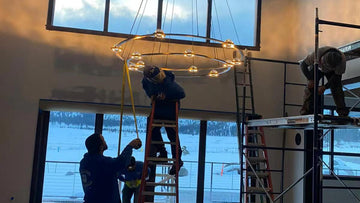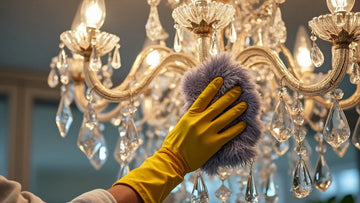Upgrading a ceiling light fixture is one of the easiest and most effective ways to refresh your space. Whether you’re swapping out an outdated fixture for a modern design or simply improving lighting efficiency, this DIY project can be completed in just a few steps. In this guide, we’ll cover essential tools, safety precautions, wiring basics, and expert techniques to ensure a seamless and secure installation.
1. Essential Tools & Materials for a Hassle-Free Installation
Before you start, gathering the right tools will save time and prevent unnecessary complications. Here’s what you’ll need:
🔧 Basic Hand Tools
✔ Screwdrivers (flat-head & Phillips-head)
✔ Wire strippers & cutters
✔ Pliers (needle-nose and lineman’s)
✔ Utility knife
✔ Measuring tape
🛡 Safety Equipment
✔ Voltage tester (to confirm power is off)
✔ Safety glasses (to protect your eyes from debris)
✔ Insulated gloves (for extra protection)
✔ Sturdy ladder or step stool
⚡ Optional Specialized Tools
✔ Cordless drill with bits (for secure mounting)
✔ Electrical tape (to secure connections)
✔ Nut drivers (for tightening nuts and bolts)
2. Safety First: Essential Precautions Before Starting
Working with electricity requires caution. Follow these critical steps to avoid hazards:
✅ Shut Off Power at the Circuit Breaker
- Locate the correct breaker and turn it OFF.
- Double-check by flipping the light switch—if the light doesn’t turn on, the power is off.
- Use a voltage tester to confirm no live wires remain.
✅ Secure a Stable Working Area
- Position your ladder on a level surface to prevent falls.
- Ensure the new fixture’s weight is compatible with your ceiling’s electrical box.
✅ Wear Protective Gear
- Use safety glasses to protect against dust and debris.
- Insulated gloves provide an extra layer of protection while handling wires.
✔ Pro Tip: If you’re unsure about wiring or safety precautions, consult a qualified electrician.
3. Step-by-Step Guide: How to Replace a Ceiling Light Fixture
Follow these steps for a professional-looking installation:
Step 1: Remove the Old Fixture
🔹 Turn off power at the circuit breaker.
🔹 Remove the light bulbs and decorative covers.
🔹 Unscrew the old fixture from the ceiling carefully, exposing the wiring.
🔹 Take a photo of the existing wiring to use as a reference.
🔹 Disconnect wires by unscrewing wire nuts and untwisting the connections.
✔ Pro Tip: If the old fixture is heavy, have someone hold it while you disconnect the wires.
Step 2: Inspect the Electrical Box
🔹 Ensure the electrical box is securely mounted to the ceiling.
🔹 If the box feels loose, tighten the screws or replace it with a support-rated ceiling box for heavy fixtures.
Step 3: Install the Mounting Bracket
🔹 Attach the new mounting bracket to the electrical box using screws.
🔹 Ensure the bracket is level and firmly secured—this will support the weight of the new fixture.
✔ Pro Tip: Some chandeliers or pendant lights require a reinforced mounting bracket—check the fixture’s weight capacity before proceeding.
Step 4: Connect the Wires Properly
Understanding Your Home’s Electrical Wiring
Before connecting wires, here’s what each wire color means:
| Wire Color | Function |
|---|---|
| Black (or Red) | Hot wire (carries electricity) |
| White | Neutral wire (returns power to the circuit) |
| Green or Bare Copper | Ground wire (prevents electrical shock) |
Wiring the New Fixture
🔹 Match wires by color: black to black, white to white, green to ground.
🔹 Strip ¾ inch of insulation from each wire if necessary.
🔹 Twist wires together clockwise, then secure them with wire nuts.
🔹 Wrap electrical tape around the base of each wire nut for extra security.
🔹 Attach the ground wire to the grounding screw in the electrical box.
✔ Pro Tip: If your home has older wiring without a ground wire, consult an electrician for safe grounding solutions.
Step 5: Mount the New Fixture & Final Adjustments
🔹 Carefully align the fixture with the mounting bracket.
🔹 Secure it using screws or locking rods provided in the fixture’s kit.
🔹 Install light bulbs with the correct wattage to prevent overheating.
✔ Pro Tip: If your fixture has an adjustable chain or rod, adjust the height before securing it.
4. Testing & Finishing Touches
✅ Turn Power Back On & Test the Light
- Switch the circuit breaker back ON.
- Turn on the light switch and check if the fixture works properly.
- If the light doesn’t turn on, double-check wiring connections.
✅ Clean & Style the Fixture
- Wipe down the fixture to remove fingerprints or dust.
- Use LED bulbs for energy efficiency and longevity.
- If the fixture has glass covers, install them securely.
✔ Pro Tip: Add a dimmer switch for adjustable lighting control—perfect for ambiance and energy savings.
5. Common Issues & Troubleshooting
⚠ The light flickers or doesn’t turn on:
✔ Check wire connections—a loose wire might be the issue.
✔ Confirm the circuit breaker is fully switched on.
✔ Test the light socket with a different bulb.
⚠ The new fixture is too heavy for the electrical box:
✔ Upgrade to a support-rated ceiling box.
✔ Use an additional ceiling brace for stability.
⚠ Exposed wires or sparks when connecting:
✔ STOP IMMEDIATELY and turn off the power.
✔ Call a licensed electrician for assistance.
Final Thoughts: Enjoy Your New Light Fixture!
Replacing a ceiling light fixture is a rewarding home improvement project that enhances both style and functionality. By following proper safety measures, securing the wiring correctly, and mounting the fixture properly, you’ll achieve a polished, professional-quality result.
✨ Ready to upgrade your lighting? Browse our collection for modern, timeless designs that transform your space effortlessly! ✨
👉 View Product











